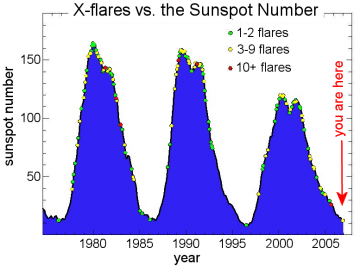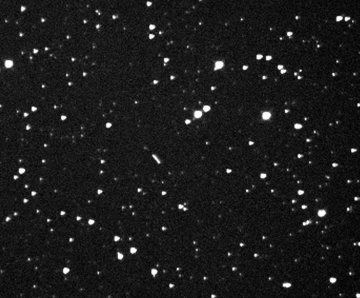 Would you like a call when auroras appear over your hometown? Sign up for Spaceweather PHONE.
Would you like a call when auroras appear over your hometown? Sign up for Spaceweather PHONE.
THE NEXT SOLAR CYCLE: Evidence is mounting that the next solar cycle, due to peak in 2010 or 2011, is going to be a big one. Get the full story from Science@NASA.
SOLAR MINIMUM EXPLODES: Big sunspots. X-flares. Geomagnetic storms and auroras. This is solar minimum?
It is indeed. "All solar minima have solar flares and geomagnetic storms," says solar physicist David Hathaway, "and the solar minimum of 2006 is no exception." To illustrate the point, he made this plot showing the monthly number of X-flares vs. sunspot number:

A close look shows flares popping up at all phases of the solar cycle. Even at low ebb, notes Hathaway, the sun can be impressively active. What does it mean? Astronauts can never relax, while sky watchers always have something to look forward to.
2004 XL14: One of these stars is not like the others. Can you find the misfit?

Photo details: 14" telescope, SBIG CCD, 30s exp.
"The streak near the center of this image is not a star but a near-Earth asteroid," says photographer John Chumack of Yellow Springs, Ohio. "2004 XL14 is about 225 meters long and it passed by Earth last night only ten times farther away than the Moon." He recorded the flyby in a 30 second exposure through his homemade 14-inch telescope.
He also made a movie: 1 MB Windows Media. "It's amazing how fast this thing was moving, about 8 miles per second or 30,000 mph!"
There's no cause for alarm. Asteroids fly by Earth all the time without hitting. Next up: 2006 XD2, a 260 meter-wide rock passing 10.7 lunar distances from Earth on Dec. 24th. If you have a suitable telescope, you can catch it racing through the constellation Draco on Christmas Eve: ephemeris.

